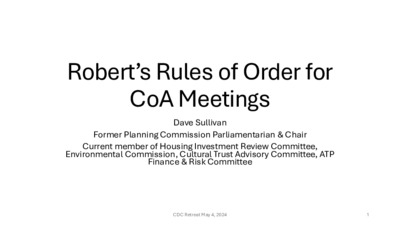Item9-Roberts Rules of Order for CoA Meetings — original pdf
Backup

Robert’s Rules of Order for CoA Meetings Dave Sullivan Former Planning Commission Parliamentarian & Chair Current member of Housing Investment Review Committee, Environmental Commission, Cultural Trust Advisory Committee, ATP Finance & Risk Committee CDC Retreat May 4, 2024 1 Robert’s Rules…. from Wikipedia https://en.wikipedia.org/wiki/Robert%27s_Rules_of_Order • A U.S. Army officer, Henry Martyn Robert (1837–1923), saw a need for a standard of parliamentary procedure while living in San Francisco. He found San Francisco in the mid-to-late 19th century to be a chaotic place where meetings of any kind tended to be tumultuous, with little consistency of procedure and with people of many nationalities and traditions thrown together. • The first edition of the book, whose full title was Pocket Manual of Rules of Order for Deliberative Assemblies, was published in February 1876 by the then-Major Robert, with the short title Robert's Rules of Order placed on its cover. CDC Retreat May 4, 2024 2 Lots of resources • https://robertsrulesmadesimple.com/ • Robert's Rules in Plain English, 2nd edition, Doris Zimmerman, HarperCollins Publishers, 2009 CDC Retreat May 4, 2024 3 Main Principles: • Only one motion can be discussed at a time. • Everyone has the right to participate in discussion before anyone may speak a second time. • Everyone has the right to know what is going on at all times. • Only urgent matters may interrupt a speaker. CDC Retreat May 4, 2024 4 Following presentation of an agenda item, and citizens speakers • Chair calls for a motion. • Generally, the chair facilitates the discussion, but she can also make or second a motion. • A motion, once made, must be seconded before discussion/debate begins. The maker and seconder get to explain why they put forward the motion. • Following the motion/second, the chair facilitates an orderly discussion or debate. Board rules may limit the time a member can speak. • One must wait until after everyone else has spoken before speaking a second time, unless it is to answer a question posed by another speaker. CDC Retreat May 4, 2024 5 Types of motions… • Main motion (or base motion) on an agenda item. Req’s 2nd. • Amendment to main motion. Req’s 2nd. • Limit debate/Call for a vote. Req’s 2nd. Requires 2/3 vote… (8 yeas out of 11 members). • Postpone. Req’s 2nd. • Recess, Adjourn, Req’s 2nd. • Table a motion. Req’s 2nd. • Remove from the table (take up the issue). Req’s 2nd. CDC Retreat May 4, 2024 6 Types of motions… • Main motion – “I move we approve project XTZ.” • Secondary motion – A motion about the main motion. Can be taken up during the discussion of the main motion. • Subsidiary motion - “I move that we refer project XYZ to the capital planning committee.” • Privileged motion – “I move that we recess for lunch.” • Incidental motion – “I move that we vote by paper ballot.” CDC Retreat May 4, 2024 7 Quick Reference CDC Retreat May 4, 2024 8 Speedy Action… • When it’s obvious that there is no objection to am matter, the chair can quickly move things along by simply asking whether there is any opposition to a questions, and hearing none, declare the motion as passed. • Examples: • The agenda is complete, the meeting is apparently done, the chairs says, “Anyone object to adjourning? Hearing no objection, this meeting is adjourned at XX:XX pm. Thanks everyone!” • An amendment is offered to a motion to clarify the language without affecting the aim of the motion, and the chair says: “Anyone object to the amended language? Hearing no objection, the amended language is accepted.” • An “friendly” amendment is offered to add to the motion, say, by adding a timeline for implementation or suggesting additional public notification, without affecting the aim of the motion, and the chair says: “Anyone object to the ‘friendly’ amendment? Hearing no objection, the amendment is accepted.” • Of course, if someone objects, then a motion, second, discussion, vote will be required. CDC Retreat May 4, 2024 9 Officer elections • CoA commissions usually have chair, vice-chair, secretary elected from the membership. • Sometimes there is nominations committee to forward candidate names to the whole commission. Since most commissions are 11 or so members, “nom comm” not always needed. • When nominations are made from the floor, no 2nd is needed. • A person can nominate themself. • The chair can ask “anymore nominations, hearing none, nominations are closed”. (Unless someone objects….) CDC Retreat May 4, 2024 10 Happy Meetings!!!! CDC Retreat May 4, 2024 11